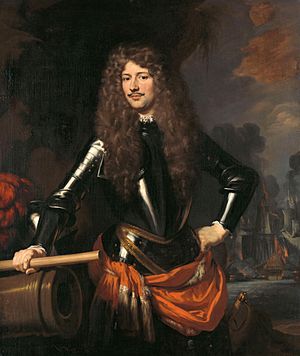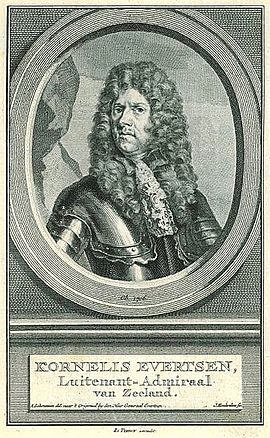Cornelis Evertsen the Youngest facts for kids
Quick facts for kids
Cornelis Evertsen the Youngest
|
|
|---|---|
 |
|
| Supreme Commander Confederated Dutch Navy | |
| In office 1684–1690 |
|
| Lieutenant Admiral of Zeeland | |
| In office 1684–1706 |
|
| Vice Admiral of Zeeland | |
| In office 1679–1684 |
|
| Personal details | |
| Born | 16 November 1642 Vlissingen, Dutch Republic |
| Died | 16 November 1706 (aged 64) Vlissingen, Dutch Republic |
| Signature | |
| Military service | |
| Rank | Admiral |
| Battles/wars | |
Cornelis Evertsen the Youngest (born November 16, 1642 – died November 16, 1706) was a brave Dutch naval officer. He came from Vlissingen in the Dutch Republic. Cornelis became a top leader in the Royal Netherlands Navy. He was known for his excellent service in several major wars. These included the Second Anglo-Dutch War and the Third Anglo-Dutch War. He also fought in the Franco-Dutch War and the Nine Years' War. His family had many famous admirals, including his father, Cornelis Evertsen the Elder.
Contents
Cornelis was born in Vlissingen. He was the second son of Lieutenant-Admiral Cornelis Evertsen the Elder. His uncle, Johan Evertsen, was also a Lieutenant-Admiral. Cornelis was often confused with his cousin, Cornelis Evertsen the Younger. People called him Keesje den Duvel, which means "Little Cornelis the Devil." This was because he had a strong, fiery personality, just like his father.
Cornelis started sailing on his father's ship when he was only ten years old in 1652. In 1665, during the Second Anglo-Dutch War, he became a privateer. This meant he was a private ship captain allowed to attack enemy ships. On April 15, 1665, his two ships were defeated by three English ships. He was captured by the English. His crew had to stop him from blowing up his own ship, the Eendragt.
Because his father and uncle were famous, the English king took an interest in him. The king's brother, James, the Duke of York, asked Cornelis about a bullet hole in his hat. He apologized for damaging his clothing. Cornelis bravely replied that he was proud of the hole. He wished it had been a bit lower, so he wouldn't be a prisoner.
A King's Release
On April 24, 1665, King Charles II of England himself released Cornelis. The king was impressed by Cornelis's quick wit. He also remembered how Cornelis's family had helped him when he was in exile. The king gave Cornelis money and a passport to return home. This act also aimed to cause trouble between different parts of the Dutch Republic.
Fighting in Major Battles
After returning in 1665, Cornelis volunteered to fight in the Battle of Lowestoft. He served on his father's main ship. In July, he became a captain with the Admiralty of Zeeland. In 1666, Cornelis was captain of the Walcheren, his father's flagship. This was during the Four Days Battle. He saw his father die during the first night of the battle. His father was hit by a cannonball from an escaping English ship.
Cornelis also fought in the St. James's Day Battle, where his uncle was killed. After this battle, Cornelis was promoted to Vice Admiral in 1666. This made him the youngest Admiral in the Zeeland Admiralty.
The Third Anglo-Dutch War
Before the Third Anglo-Dutch War officially began, English merchants wanted to control more of the West African coast. They formed a company to compete with the Dutch. An English fleet, led by Sir Robert Holmes, tried to capture Dutch merchant ships. Holmes had already captured Dutch settlements in Africa.
Cornelis Evertsen commanded the Dutch naval escort fleet. He successfully stopped Holmes's attack on March 12, 1672. This action, along with the English taking Dutch trading forts, helped start the war.
Battles and Raids
At the Battle of Solebay, Cornelis commanded the Swaenenburgh (44 guns). In 1673, with Jacob Binckes, his fleet raided English and French islands in the Caribbean. They captured many ships. They also helped Dutch Surinam with soldiers and supplies. They retook Saba and Sint Eustatius, which the English had captured.
The expedition then sailed to North America. They attacked Hampton Roads and captured or destroyed most of the English tobacco fleet. This fleet was ready to sail to London. They also landed soldiers and burned several plantations.
While in the James River, Evertsen learned about Fort Amsterdam (now in New York City). He sailed north to recapture New Amsterdam on Manhattan Island. On August 7, 1673, Evertsen and Commodore Jacob Binckes arrived with 23 ships and 1,600 men. The fort's commander, Captain John Manning, was alarmed. The fort had only 60-80 men and 30-36 guns.
Evertsen demanded the fort's surrender. He said his commission was "stuck in the barrel of a cannon." After a short fight, the Dutch recaptured the fort on August 9. They promised the colonists they would govern them fairly.
The expedition then raided the Newfoundland fisheries. They destroyed a fort, homes, and fishing areas. They captured many fishing boats and merchant ships full of fish. In total, they captured 34 prizes before returning to Europe.
After the War
On their way back, one of Evertsen's ships, the Schakerloo, fought an English ship, the HMS Tyger. The English ship won. Unknown to them, the battle happened a day after the war officially ended.
When Cornelis returned in July 1674, he was accused of not following orders. His real orders were to conquer Saint Helena and Cayenne. But a strong English fleet there prevented this. New York was given back to England in exchange for the English leaving Suriname. This gave the Dutch full control of Suriname. The tiny spice islands of Ai and Run were also given to the Dutch. This gave them a complete control over the spice trade.
Admiral of Zeeland
In January 1675, Cornelis became a Rear-Admiral for the Admiralty of Zeeland. In 1677, he led a blockade against ships from Dunkirk. In 1678, his squadron of nine ships fought a French squadron near Wissant. Despite a strong storm, the fighting was fierce. Both sides took damage, but no ships were lost.
On September 20, 1679, he became Vice-Admiral, replacing his cousin. On April 1, 1684, he became Lieutenant-Admiral of Zeeland. He also became the supreme commander of the combined Dutch fleet. In 1688, he led the front part of the invasion fleet for William III of England during the Glorious Revolution.
Battle of Beachy Head
In 1690, Cornelis commanded the front part of the combined Anglo-Dutch fleet. This was at the Battle of Beachy Head (1690). His force of 20 warships faced a much larger French fleet of 75 ships. He held off the French attack without much help from the main fleet commander, Arthur Herbert, 1st Earl of Torrington.
Evertsen saved most of his squadron by using a clever trick. While sailing fast, he suddenly dropped anchor. This allowed the strong tidal current to carry the French fleet away before they realized what happened. The French then chased the rest of the English fleet. Lord Torrington was later removed from his command.
After 1690, Cornelis never commanded a fleet again. He died in 1706. Cornelis is buried in Middelburg, Zeeland, under the tomb of his father and uncle. His younger brother, Geleyn Evertsen, became Lieutenant-Admiral of Zeeland after him.
Personal Life
According to family records, Cornelis Evertsen the Youngest never married. There are no known records of him having any serious romantic relationships.


